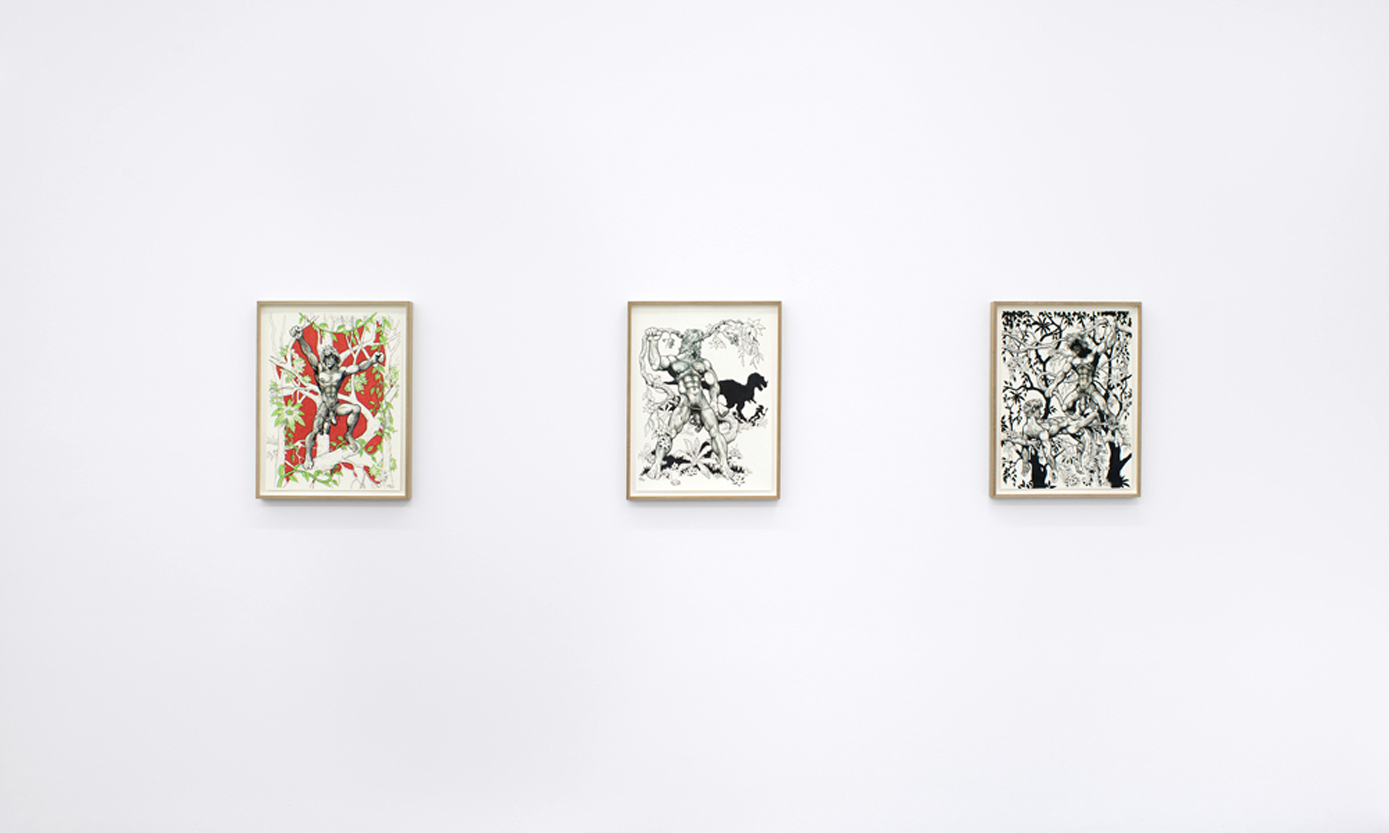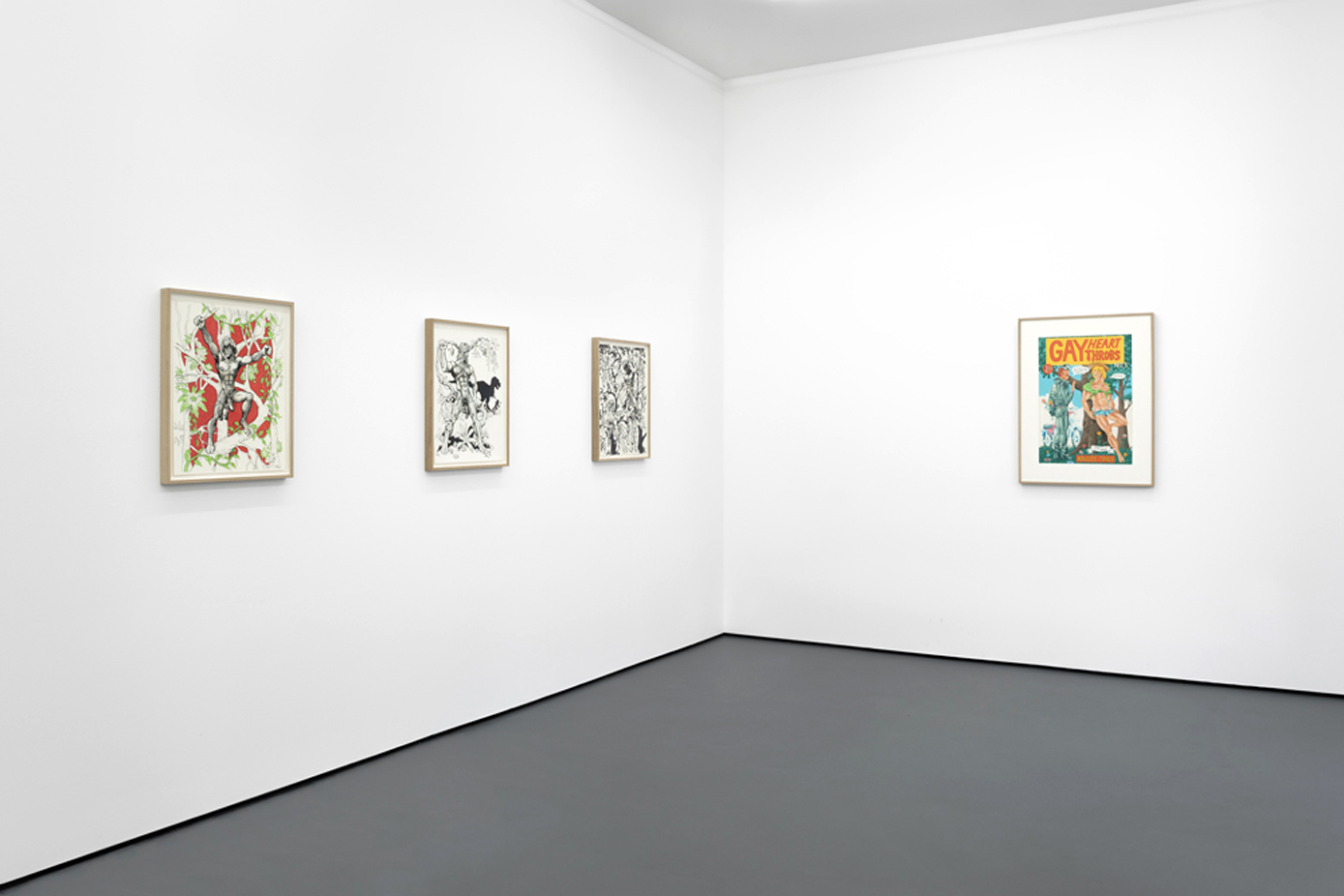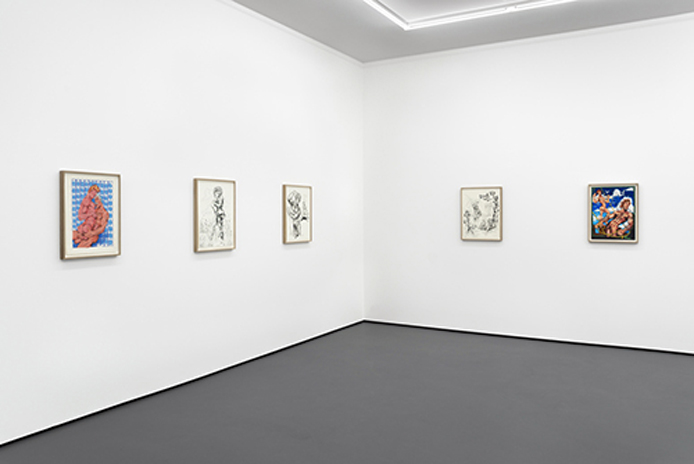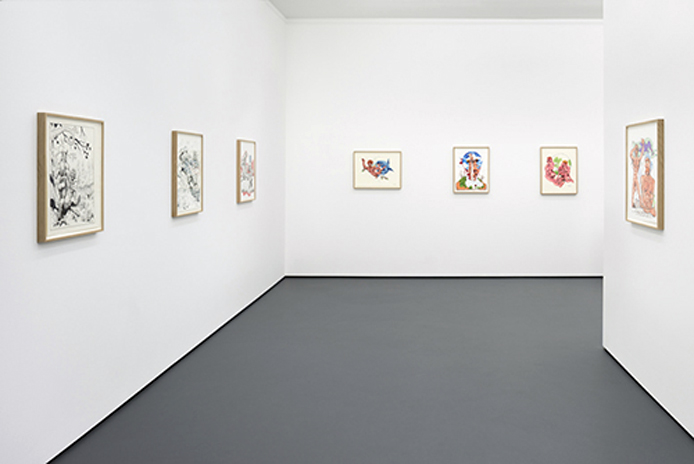MIKE KUCHAR: Brave, Bold and Bare
November 8, 2014 - January 10, 2015
THE FLESHY FANTASIES OF MIKE KUCHAR
Sam Ashby
“What are these acts of creation we do in paint or on film? Are they linked or related to Creation itself—the very force that gives motion, light, and form to the universe... or am I just a guy warding off boredom with a hobby that substitutes for his loneliness?”
—Mike Kuchar
I first encountered Mike Kuchar’s drawings before his films, in the pages of Meatmen, a compendium of underground gay comics I found on the bookshelves of a gay sex shop in Brighton. It was my first trip to the British gay mecca as a recently “out” 20-year-old. I shyly purchased a copy, along with a back issue of Colt, the first entries into what would become an ever-expanding masturbatory archive. It wasn’t until a decade later that I would eventually connect the mysterious “Mike,” whose name signed my favorite comic in that book, with Mike Kuchar, whose anarchic 8mm micro-epics, made with his twin brother, George, had captured my attention and imagination as a late-blooming underground film fetishist.
Mike’s men exude a relaxed charm and an ability to feel at home in their surroundings— whether escaping dinosaurs, fending off hungry sharks, swinging through the trees, or simply bathing in a river with a buddy. Their unkempt hair and stubble seem distinctly California, where Mike has made his home, in San Francisco, since 2007, and their bodies seemingly the result of an outdoor lifestyle of heavy lifting, and a diet of raw meat. “I put the characters in situations that are visually exciting,” Mike explains when I call him one afternoon to discuss his work. “I’m a fan of pop culture, movie posters, and comic books. I grew up on all that stuff. I tried to make cartoons that were juicy, not just funny or silly, but were actually fleshy.” For Mike this hand-drawn fantasy realm fulfills the space that film, and indeed the physical, cannot, and it is this difference that is key to understanding their place alongside his film work. Rendered exquisitely in felt-tip pen and inks, Mike’s more unattainable sexual fantasies can exist. “That’s what it’s about,” he says, simply. “I get an image in my head, an image with a certain feeling or quality. The idea is to project it out of yourself into a medium that can contain that vision. It’s a meditation to apply it to the movie screen or onto paper. It’s about finding control of the medium so I can manipulate my visions.”
It was a friend of Mike’s who first recommended he pursue becoming a comics artist. Mike was introduced to a writer for the underground gay comic Gay Heart Throbs in the late 1970s, who would send Mike stories with suitably erotic potential, such as the rise and fall of a Roman gladiator, which he would sketch up. Never using models, only his imagination, and getting certain details such as veins and hair growth right by observing himself in the mirror, Mike would render the panels in large formats and in monochrome. “The illustrations for stories were my own idea,” Mike notes. “You just interpret it onto the paper or take elements and possibilities to see if you can dress up the stories or maybe even make the drawings better than the stories.”It wasn’t long before Mike’s comics were getting quite a bit of attention from some of his audience. “I would get heavy-breathing phone calls,” Mike chuckles. “I didn’t like it too much; they would call at odd hours! The work turned them on, but it’s the work, it’s not me. They called me as if it was a sex service!” Other editors saw similar potential in Mike’s comics and soon his drawings were appearing in other popular gay magazines of the time including Manscape and First Hand. “I had deadlines so would do them fast, but after they sent them back I would elaborate on the drawings that I felt had potential, incorporating new things in the landscape and even adding color.” These publications flourished through the 1980s but eventually began to die out with the burgeoning market of video pornography, and so the call for Mike’s drawing work diminished. It is only recently that he has returned to the form, revisiting his images of male glamor and exhibiting them in the gallery and museum context, unearthing some that have not been seen for 30 years.
In part because of that time, a feeling often arises with Mike’s work of having discovered something incredible—that glimmer of recognition combined with the gloriously unfamiliar. It’s present in his hand—the line: intentional, labored, and innocent. Opening these imaginings of our youth, he invites us to explore the potential of his private world for fulfillment.
As editor of Little Joe magazine, a companion of queer filmic encounters, my work is often in dialogue with the past, and attempts to distill that certain sense of discovery. I think every generation must feel somewhat detached from the previous one, and growing up queer I was automatically displaced from a collective history. In gradually discovering my heroes—Derek Jarman, Andy Warhol, Kenneth Anger, Barbara Hammer, George and Mike—I became aware of a queer family of uncles and aunts, an intergenerational support group, even if they weren’t here with us. Their work guides us to other ways of life, or simply illuminates the beauty present in our own.
I was born in 1981, just four days before the New York Times published an article by Lawrence K. Altman titled “Rare Cancer Seen in 41 Homosexuals” on July 3, so my life has been defined by HIV and AIDS, but in a way I only became aware of them much later in life. These were not my friends and lovers dying, but rather people whose work I would come to adore, men whom I could access only via their work, or through the memories of their surviving friends. The loss that so many people endured is a loss that echoes through time, and is felt loudly today. Investigating this recent past is such a necessary aspect of queer cultural production presently, and it has been a strong line of investigation in a number of recent group exhibitions, including ‘Coming After’ curated by Jon Davies at the Powerplant in Toronto in 2011; This Will Have Been: Art, Love, and Politics in the 1980s, curated by Helen Molesworth at Chicago’s Museum of Contemporary Art in 2012; and The Temptation of AA Bronson, at Witte de With in 2013. The spectre of AIDS loomed large over all of them.
Mike’s earlier drawings unfolded across the pages of underground comics read by eager men, young and old, whose access to visual stimuli of the erotic was a relatively recent possibility at that time. Even today, with the prevalence and easy accessibility of gay pornography online, there is a quality to his drawings that continues to surprise—a rare vision of a time when the power of the images to arouse and amuse was even greater, and certainly necessary. For me, Mike’s work is a necessary queer reading of American culture, and it’s one that he began early. He and his twin brother, George, grew up in the Bronx in the late 1950s, then one of New York’s most deprived neighborhoods. After school their mother would take them to movie theaters that offered free food with the ticket price, and so while they filled their stomachs, they also fed their imaginations. Instilled through repeat of viewings of Douglas Sirk melodramas, B-movie sci-fi, and exploitation flicks, the brothers’ films display an innate understanding of the conventions of Hollywood genre flicks, filtered through their own distinctively perverse sense of humor. With titles such as The Naked and the Nude (1957), I Was a Teenage Rumpot (1960), and Lust For Ecstasy (1963), the films are tawdry tales of bored housewives and sexually frustrated young men— working low-budget, with low production values, and featuring hand-drawn animation sequences, and DIY special effects.
Their audience largely consisted of family and friends and amateur movie clubs, until a chance opportunity to screen their films at the Manhattan loft of Ken and Flo Jacobs brought their work to an entirely new milieu: New York’s avant-garde film scene. Soon Mike and George were screening their films alongside the likes of Kenneth Anger, Gregory Markopoulos, Jack Smith, Stan Brakhage, and Andy Warhol, with praise from Jonas Mekas in his “Movie Journal” column at the Village Voice. “It was a very exciting time,” Mike recalls. “It was an exchange. Everyone worked separately and had their own vision, but we’d all meet up at the premieres.”
Unlike many of their peers, who chose to work in 16mm, Mike and George used a cheap 8mm camera given to them by their mother for Christmas, and another on loan from an aunt. It was “a despised format,” as Mike describes it, one that had been developed for the home movie market and had found little use beyond the confines of the domestic. But the format’s diminutive gauge and affordability was just what appealed to their feverish imaginations, and George would later defend the format just as he was preparing to leave it behind for 16mm. In his “8mm Manifesto,” published in Mekas’s column on December 17, 1964, George wrote: “Having worked with 8mm for twelve years, I have seen what it can do to a person. The creative intellect undergoes a great revolt and the bars of restraint are ripped from the casement of sanity until everything is a whirlpool of incandescent pudding.”
Encouraged by their new found recognition, Mike and George could barely make enough films to keep up with their imaginations—they had already completed 15 films before they parted ways as co-directors, during the making of Corruption of the Damned, in 1965. It was merely an aesthetic divergence, but one that allowed Mike to explore his own approach. Corruption of the Damned, their first film in 16mm, became a George picture, while Mike went on to make Sins of the Fleshapoids (1965), a low-budget approximation of the science fiction oddity The Creation of the Humanoids (1960), Andy Warhol’s favorite movie.
In the years that followed, Mike carved out his own brand of Kuchar, making complex and melancholic films such as The Secret Of Wendel Samson (1966) and The Craven Sluck (1967), which addressed issues of sexual identity with tenderness and humor, set against scenes of shootouts and alien abductions. He adopted video in the 1980s and churned out an extraordinary array of melodramas and horrors, while his most recent digital daydreams have begun to explore a more lyrical, yearning poetic. “Sometimes you see a person and they have a certain quality, they affect you in a certain way— they haunt you in a certain way, and I try to get that element onto the screen,” Mike explains. Casting these beautiful young men in his poem pictures, Mike makes use of lurid colors and the kitschiest visual effects his computer can provide in order to distill a moment of soul-searching and inner turmoil.It is easy to place Mike’s drawing work in the context of his past, or indeed to draw links to contemporary queer graphic novel and comic artists such as Alison Bechdel, Zack, and Eric Kostiuk Williams. But despite originally working in the storyboard comic style, Mike’s work seems genuinely focused on the single image. I find a coherence in recent artists such as Cary Kwok—whose exquisitely detailed drawings hung alongside Mike and Tom of Finland at the recent exhibition Keep Your Timber Limber (Works on Paper), at London’s ICA in 2013—and British artist Simon Foxall, who displays a similarly detailed sense of kitsch. Other surprising connections draw me to the contemporary realm of Internet fan-fiction and user-made artwork, where the enduring pleasure of portraying fictional pop- cultural characters in homoerotic situations persists in countless queer versions, which are circulated online on websites such as DeviantArt and Tumblr. Mike injects an element of masculine glamor and camp into the timeworn tropes of his youth, and to observe his work is in some ways to covet this history of desire, and to invent our own.It is a privilege to have Mike still producing. In some ways, he could be seen as a direct line to a time before AIDS, something that is present in the unfettered sexuality of his men. The renewed interest in his work, alongside that of Tom of Finland and the male physique photographer Bob Mizer attests to the recognition of the politics inherent in these early gay works of underground art. But Mike’s continued production denies the “pre- and post-” dichotomy that AIDS so violently defined. Mike looks back, not to a time before, but to a land before time, a world in which his men simply exist in the glades and grottoes of the imagination.
Sam Ashby is an artist, writer, publisher, and graphic designer based in London, UK. (littlejoemagazine.com)
KIMMERICH
WeydingerstraBe 6, 10178 Berlin
info@kimmerich.com




